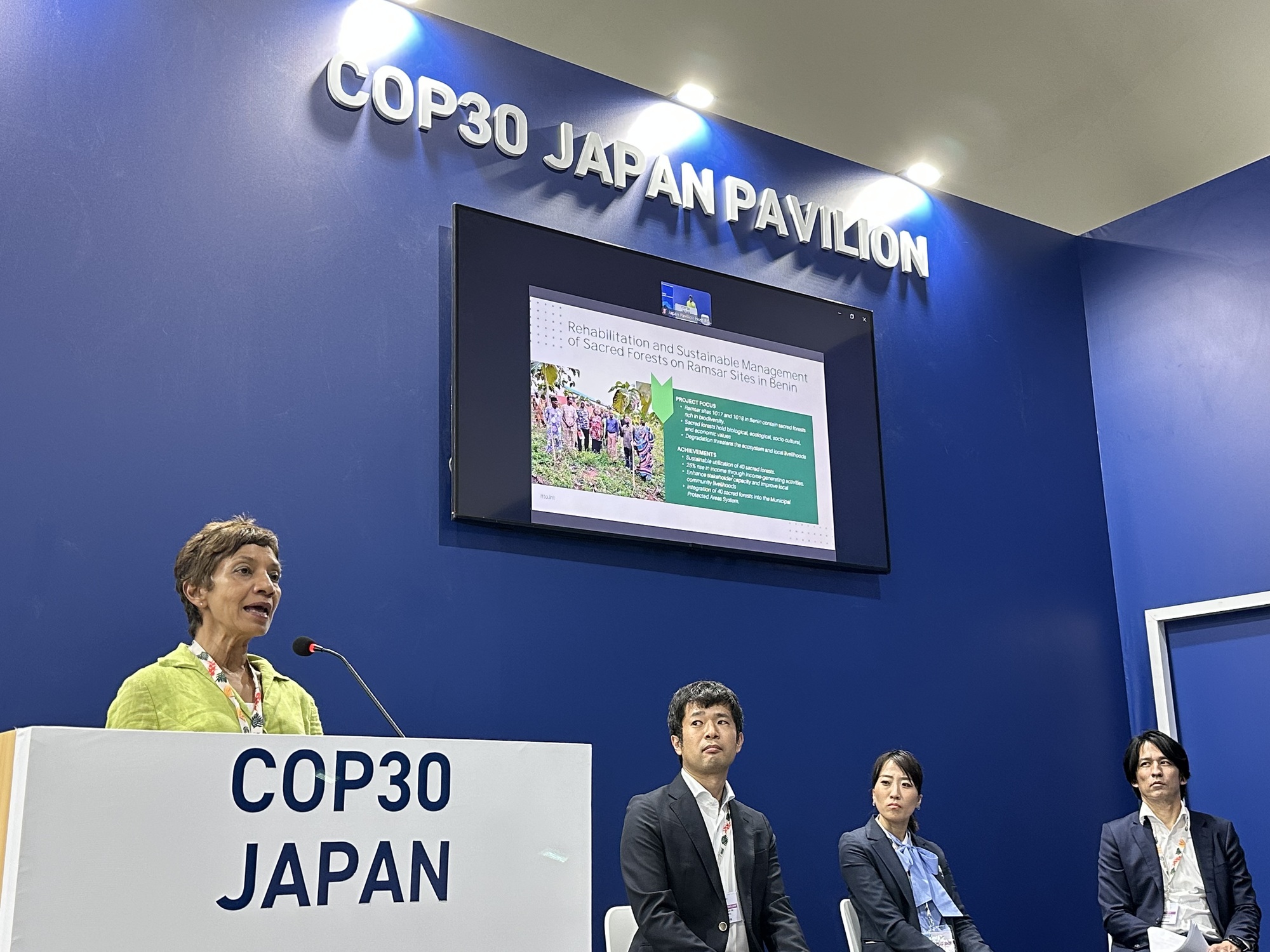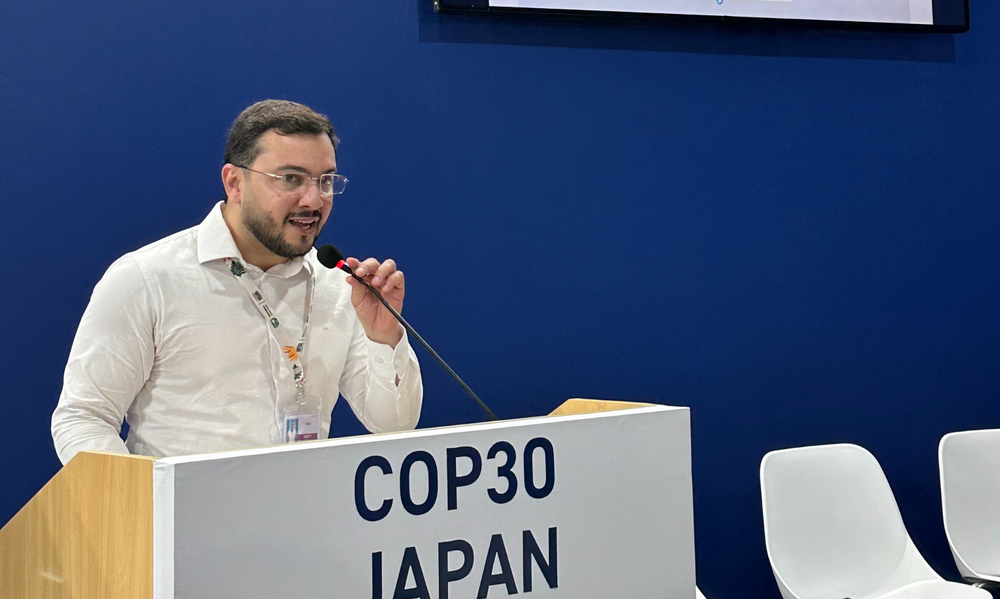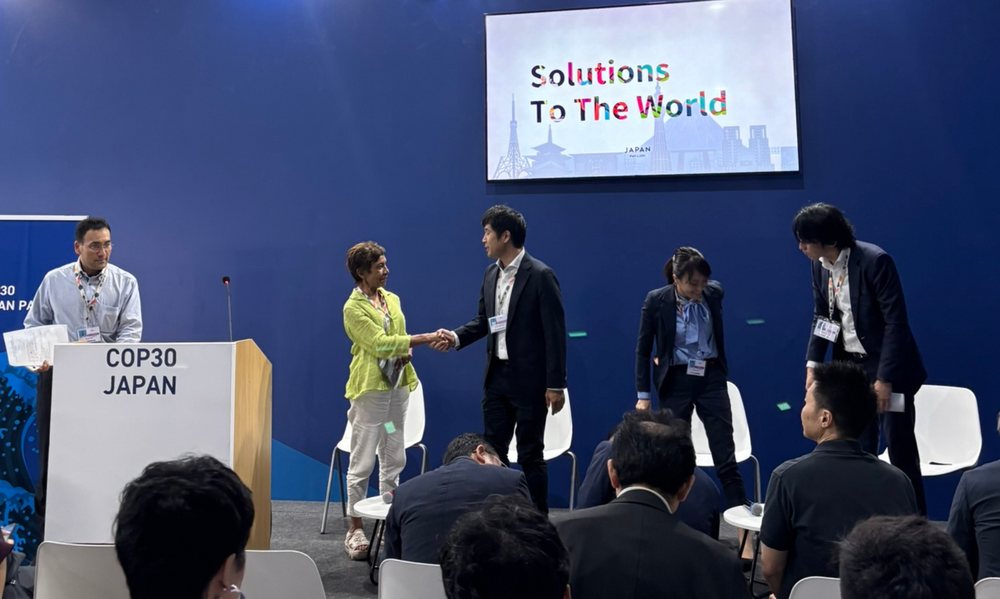COP30: Harnessing the power of forests and blue carbon as vital climate solutions
20 November 2025, Belém

During two sessions held at a COP30 side event, ITTO Executive Director Sheam Satkuru highlighted how forests already serve as high impact nature-based solutions and underscored the immense carbon storage capacity and vital services provided by mangroves. © Ramon Carrillo/ITTO
Forests, agroforestry and blue carbon ecosystems took centre stage at an event held at the Japan Pavilion during COP30, where experts and officials from Japan and Brazil showcased how land and ocean sectors can drive global progress toward the 1.5°C goal. The event, “Promoting Climate Change Mitigation Measures in Agriculture / Forestry Sectors and Blue Carbon,” brought together government leaders, research institutions, private sector partners and international organizations, including ITTO Executive Director Sheam Satkuru.

Framing forests and blue carbon as indispensable climate allies
Opening remarks by senior officials from Japan and Brazil set an optimistic tone for the seminar. Brazil’s Vice-Minister of Fisheries and Aquaculture, Rivetla Edipo Araujo Cruz, underscored the historic role of Japanese expertise in shaping Brazil as a “forest country,” emphasizing that the two nations’ collaboration in forestry, agriculture and coastal resource management continues to be a cornerstone for climate action and rural development.
Speakers highlighted that forests, mangroves, seagrass, and other blue carbon ecosystems offer far-reaching co-benefits—from biodiversity conservation to soil and water protection—making them essential pillars of climate mitigation and resilience.

Forests as climate solutions: ITTO highlights global progress
In the agriculture and forestry panel, Ms Satkuru outlined ITTO’s mandate to promote sustainable tropical forest management alongside legal and sustainable tropical timber trade—an agenda shared by the Organization’s 76 member countries, which together represent more than 80% of the world’s tropical forests and 90% of trade.
She highlighted how forests already serve as high-impact nature-based solutions by avoiding emissions through reforestation, sequestering and storing carbon through restoration and sustainable management, and enabling low-carbon development and material substitution through the use of sustainably produced wood products. Examples from ITTO-supported initiatives, including women-focused livelihood projects, demonstrated how climate mitigation, forest conservation and social inclusion go hand in hand.
Ms Satkuru also noted ITTO’s expanding engagement in blue carbon, bridging terrestrial and coastal forest strategies.

Monitoring restoration, advancing agroforestry and strengthening forest management
Other panellists showcased practical innovations emerging from Japan–Brazil collaboration:
- Sustainacraft and Conservation International Brazil presented a remote-sensing and modelling approach for large-scale monitoring of restoration under Brazil’s national restoration plan, PLANAVEG—helping improve transparency and unlock climate finance.
- Fruta Fruta and CAMTA, a cooperative founded by Japanese immigrants in Pará, shared insights on Amazonian agroforestry value chains. Their work illustrates how agroforestry enhances soil and water conservation, boosts biodiversity and delivers resilient livelihoods. A recent Japan–Brazil demonstration project is already helping farmers improve yields through technology transfer.
- Japan’s Forestry Agency highlighted Japan’s growing forest carbon stocks and its emphasis on sustainable, circular use of domestic timber. Plantation forests—many of which are nearing maturity—are integral to the country’s broader climate strategy.
Blue carbon takes the spotlight: linking land and sea
The second panel focused on coastal ecosystems and their emerging prominence in climate policy.
Ms Satkuru opened the session by underscoring the immense carbon storage capacity of mangroves and the vital services they provide for coastal protection, fisheries and community livelihoods. She shared insights from ITTO projects in Benin, Fiji, Panama and the Philippines, emphasizing the importance of seed quality, local engagement and sound restoration techniques for long-term success, adding that mangroves contribute to sustainable wood use for several applications.
Other contributions included:
- ModaDAS, presented by Nakagawara Hiroaki, a decision-support tool that identifies optimal sites for blue carbon restoration by integrating environmental, social and spatial data.
- Japan’s Ministry of Land, Infrastructure, Transport and Tourism, showcased coastal infrastructure and habitat conservation efforts that align with blue carbon objectives.
- Japan’s Ministry of the Environment, which detailed efforts to integrate coastal ecosystems into national greenhouse gas inventories and Japan’s latest nationally Determined Contributions (NDC)—an important step toward strengthening blue carbon’s role in national climate planning.

Participants noted that the formal inclusion of forests and blue carbon ecosystems into national forest and climate strategies and greenhouse gas inventories is gaining momentum worldwide, which is essential to ensure that land- and ocean-based solutions continue to effectively contribute to global climate policy. © Jorge Leyva/IFSA
Forests and coasts must move forward together
Discussions throughout the seminar underscored a shared understanding that effective climate mitigation requires action on both fronts—reducing emissions and enhancing carbon sinks—across terrestrial and coastal ecosystems. Speakers emphasized that the long-standing cooperation between Japan and Brazil is already producing tangible, scalable models, whether in restoration monitoring, agroforestry value chains or blue carbon planning tools, and that these experiences can be adapted to other national contexts.
A recurring theme was that high-integrity projects in forests and coastal ecosystems produce far more than carbon benefits. They safeguard biodiversity, improve soil and water resources, support gender empowerment and strengthen livelihoods, making them powerful instruments for sustainable development. The seminar also highlighted the critical need for robust monitoring systems, such as biomass modelling tools and spatial platforms like ModaDAS, to guide investment decisions, enhance transparency and unlock climate finance.
Finally, participants noted that the formal inclusion of forests and blue carbon ecosystems into national forest and climate strategies and greenhouse gas inventories is gaining momentum worldwide. This integration is essential to fully capture their contributions to the 1.5°C goal and to ensure that land- and ocean-based solutions continue to effectively contribute to global climate policy.
